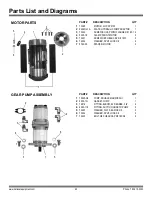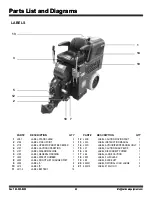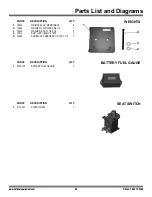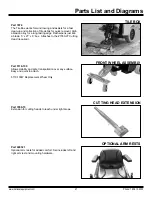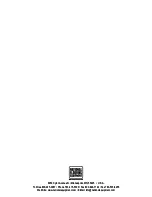
Fax: 763-535-8255
54
Material Safety Data Sheet (MSDS) Information
www.nationalequipment.com
Phone: 763-315-5300
54
EXTINGUSHING MEDIA:
Use water fog, foam, dry chemical or carbon dioxide (CO2) to extinguish
fl
ames.
PROTECTION OF FIRE FIGHTERS:
Fire Fighting instructions: This material will burn although it is not easily ignited. For
fi
res involving this
material, do not enter any enclosed or con
fi
ned
fi
re space without proper protective equipment, including self-contained breathing apparatus.
Combustion Products:
Highly dependent on combustion conditions. A complex mixture of airborne solids, liquids, and gases including carbon
monoxide, carbon dioxide, and unidenti
fi
ed organic compounds will be evolved when pounds will be evolved when this material undergoes
combustion.
ACCIDENTAL RELEASE MEASURES
Protective Measures:
Eliminate all sources of ignition in vicinity of spilled material.
Spill Management:
Stop the source of the release if you can do it without risk. Contain release to prevent further contamination of soil, surface
water or groundwater. Clean up spill as soon as possible, observing precautions in Exposure Controls/Personal Protection. Use appropriate
techniques such as applying non-combustable absorbent materials or pumping. Where feasible and appropriate, remove contaminated soil.
Place contaminated materials contaminated soil. Place contaminated materials in disposable containers and dispose of in a manner consistent
with applicable regulations.
Reporting:
Report spills to local authorities and/or the U.S. Coast Guard’s National Response Center at (800) 424-8802 as appropriate or
required.
HANDLING AND STORAGE
Precautionary Measures:
DO NOT USE IN HIGH PRESSURE SYSTEMS in the vicinity of
fl
ames, sparks and hot surfaces. Use only in well
ventilated areas. Keep container closed.
General Handling Information:
Avoid contaminating soil or releasing this material into sewage and drainage systems and bodies of water.
Electrostatic charge may accumulate and create a hazardous condition when handling this material. To minimize this hazard, bonding and
grounding may be a necessary but may not, by themselves, be suf
fi
cient. Review all operations which have the potential of generating and
accumulating an electrostatic charge and/or a
fl
ammable atmosphere (including tank and container
fi
lling, splash
fi
lling, tank cleaning, sampling,
gauging, switch loading,
fi
ltering, mixing, agitation, and vacuum truck operations) and use appropriate mitigating procedures. For more informa-
tion, refer to OSHA standard 29 CFR 1910.106, Flamable and Combustable Liquids’, National Fire Protection Association (NFPA 77, `Recom-
mended Practice on Static Electricity`, and/or the American Petroleum Institute (API) Recommended Practice 2003, `Protection Against Ignitions
Arising Out of Static, Lightning, and Stray Currents`.
Container Warnings:
Container is not designed to contain pressure. Do not use pressure to empty container or it may rupture with explosive
force. Empty containers retain product residue (solid, liquid, and/or vapor) and can be dangerous. Do not pressurize, cut, weld, braze, solder,
drill, grind, or expose such containers to heat,
fl
ame, sparks, static electricity, or other sources of ignition. They may explode and cause injury or
death. Empty containers should be completely drained, properly closed, and promptly returned to a drum reconditioner or disposed of properly.
EXPOSURE CONTROLS/PERSONAL PROTECTION
GENERAL CONSIDERATIONS:
Consider the potential hazards of this material (see Section 3), applicable exposure limits, job activities, and
other substances in the workplace when designing engineering controls and selecting personal protective equipment. If engineering controls or
work practices are not adequate to prevent exposure to harmful levels of this material, the personal protective equipment listed below is recom-
mended. The user should read and understand all instructions and limitations supplied with the equipment since protection is usually provided
for a limited time or under certain circumstances.
ENGINEERING CONTROLS:
Use in a well-ventilated area.
PERSONAL PROTECTIVE EQUIPMENT
Eye/Face Protection:
No special eye protection is normally required. Where splashing is possible, wear safety glasses with side shields as a
good safety practice.
Skin Protection:
No special protective clothing is normally required. Where splashing is possible, select protective clothing depending on
operations conducted, physical requirements and other substances in the workplace. Suggested materials for protective gloves include: 4H (PE/
EVAL), Nitrile Rubber, Silver Shield, Viton.
Respiratory Protection:
No respiratory protection is normally required. If user operations generate an oil mist, determine if airborne concentra-
tions are below the occupational exposure limit for mineral oil mist. If not, wear an approved respirator that provides adequate protection from
measured concentrations of this material. For air-purifying respirators use a particulate cartridge. Use a positive pressure air-supplying respira-
tor in circumstances where air-purifying respirators may not provide adequate protection.
CHEVRON HD 22 - 68 - HYDRAULIC FLUID (CONTINUED)
www.nationalequipment.com
Phone: 763-315-5300
54
EXTINGUSHING MEDIA:
Use water fog, foam, dry chemical or carbon dioxide (CO2) to extinguish
fl
ames.
PROTECTION OF FIRE FIGHTERS:
Fire Fighting instructions: This material will burn although it is not easily ignited. For
fi
res involving this
material, do not enter any enclosed or con
fi
ned
fi
re space without proper protective equipment, including self-contained breathing apparatus.
Combustion Products:
Highly dependent on combustion conditions. A complex mixture of airborne solids, liquids, and gases including carbon
monoxide, carbon dioxide, and unidenti
fi
ed organic compounds will be evolved when pounds will be evolved when this material undergoes
combustion.
ACCIDENTAL RELEASE MEASURES
Protective Measures:
Eliminate all sources of ignition in vicinity of spilled material.
Spill Management:
Stop the source of the release if you can do it without risk. Contain release to prevent further contamination of soil, surface
water or groundwater. Clean up spill as soon as possible, observing precautions in Exposure Controls/Personal Protection. Use appropriate
techniques such as applying non-combustable absorbent materials or pumping. Where feasible and appropriate, remove contaminated soil.
Place contaminated materials contaminated soil. Place contaminated materials in disposable containers and dispose of in a manner consistent
with applicable regulations.
Reporting:
Report spills to local authorities and/or the U.S. Coast Guard’s National Response Center at (800) 424-8802 as appropriate or
required.
HANDLING AND STORAGE
Precautionary Measures:
DO NOT USE IN HIGH PRESSURE SYSTEMS in the vicinity of
fl
ames, sparks and hot surfaces. Use only in well
ventilated areas. Keep container closed.
General Handling Information:
Avoid contaminating soil or releasing this material into sewage and drainage systems and bodies of water.
Electrostatic charge may accumulate and create a hazardous condition when handling this material. To minimize this hazard, bonding and
grounding may be a necessary but may not, by themselves, be suf
fi
cient. Review all operations which have the potential of generating and
accumulating an electrostatic charge and/or a
fl
ammable atmosphere (including tank and container
fi
lling, splash
fi
lling, tank cleaning, sampling,
gauging, switch loading,
fi
ltering, mixing, agitation, and vacuum truck operations) and use appropriate mitigating procedures. For more informa-
tion, refer to OSHA standard 29 CFR 1910.106, Flamable and Combustable Liquids’, National Fire Protection Association (NFPA 77, `Recom-
mended Practice on Static Electricity`, and/or the American Petroleum Institute (API) Recommended Practice 2003, `Protection Against Ignitions
Arising Out of Static, Lightning, and Stray Currents`.
Container Warnings:
Container is not designed to contain pressure. Do not use pressure to empty container or it may rupture with explosive
force. Empty containers retain product residue (solid, liquid, and/or vapor) and can be dangerous. Do not pressurize, cut, weld, braze, solder,
drill, grind, or expose such containers to heat,
fl
ame, sparks, static electricity, or other sources of ignition. They may explode and cause injury or
death. Empty containers should be completely drained, properly closed, and promptly returned to a drum reconditioner or disposed of properly.
EXPOSURE CONTROLS/PERSONAL PROTECTION
GENERAL CONSIDERATIONS:
Consider the potential hazards of this material (see Section 3), applicable exposure limits, job activities, and
other substances in the workplace when designing engineering controls and selecting personal protective equipment. If engineering controls or
work practices are not adequate to prevent exposure to harmful levels of this material, the personal protective equipment listed below is recom-
mended. The user should read and understand all instructions and limitations supplied with the equipment since protection is usually provided
for a limited time or under certain circumstances.
ENGINEERING CONTROLS:
Use in a well-ventilated area.
PERSONAL PROTECTIVE EQUIPMENT
Eye/Face Protection:
No special eye protection is normally required. Where splashing is possible, wear safety glasses with side shields as a
good safety practice.
Skin Protection:
No special protective clothing is normally required. Where splashing is possible, select protective clothing depending on
operations conducted, physical requirements and other substances in the workplace. Suggested materials for protective gloves include: 4H (PE/
EVAL), Nitrile Rubber, Silver Shield, Viton.
Respiratory Protection:
No respiratory protection is normally required. If user operations generate an oil mist, determine if airborne concentra-
tions are below the occupational exposure limit for mineral oil mist. If not, wear an approved respirator that provides adequate protection from
measured concentrations of this material. For air-purifying respirators use a particulate cartridge. Use a positive pressure air-supplying respira-
tor in circumstances where air-purifying respirators may not provide adequate protection.
CHEVRON HD 22 - 68 - HYDRAULIC FLUID (CONTINUED)
Содержание 5700-aus
Страница 1: ...Read Manual Before Operating Machine ALL DAY BATTERY RIDE ON SCRAPER INSTRUCTION MANUAL Rev B 401810...
Страница 2: ......
Страница 44: ...Parts List and Diagrams Fax 763 535 8255 info nationalequipment com 44 5700 BATTERY WIRING...
Страница 46: ...Parts List and Diagrams Fax 763 535 8255 info nationalequipment com 46 5700 MACHINE WIRING...

